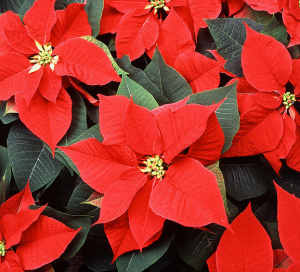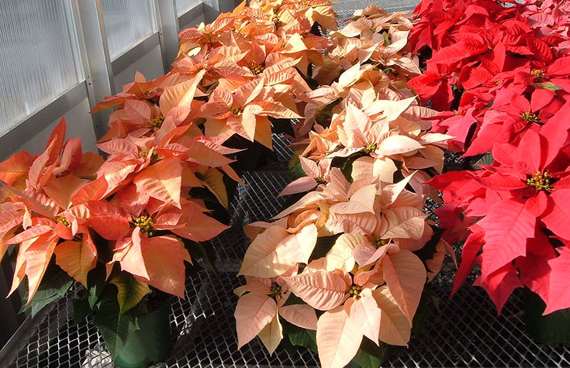Poinsettias: To Keep or Not to Keep
Posted in Horticulture on November 26 2014, by Sonia Uyterhoeven
Sonia Uyterhoeven is NYBG‘s Gardener for Public Education.

They are ubiquitous during the holiday season—and for good reason. Poinsettias (Euphorbia pulcherrima) are affordable, colorful plants with an enormous amount of festive appeal. But, contrary to popular opinion, the flowers are actually minuscule. The beauty of the poinsettia comes from its large, colorful red bracts.
Poinsettias come not only in the traditional yuletide red, but in a selection of cream-colored and rosy pink varieties as well. Whatever your tastes, they adorn many public spaces and homes during the holiday season.
I wince when I see people walking down the street with an open poinsettia in hand, fully exposed to the elements. Do your part to be an informed shopper and insist that the florist or retail store you purchase your poinsettia from wraps the plant before you leave with it. It doesn’t have to be an elaborate affair—it can be as little as temporarily covering the plant with a shopping bag. You must remember that you’re dealing with a tropical plant, and it can’t handle our area’s cool temperatures.
Poinsettias prefer an ideal home temperature somewhere in the range of 60 to 70° F. They get stressed by temperatures that drop below 50° F. If you expose them to low temperatures for long enough, you’ll soon be watching the plant collapse from the cold. As for other considerations, poinsettias prefer bright, indirect light and should be watered when the soil is dry to the touch. Avoid placing them in areas where there is a draft or excessive heat (this is a general rule for all of your houseplants).
One final caution: don’t over-water your poinsettia or let it sit in standing water. Holiday plants are often wrapped in shiny green or red foil, and this foil is often kept on since it makes the plant more attractive when the plastic pot beneath remains hidden. However, this foil can block light from reaching the lower foliage, hinder air circulation, and impede good drainage.
If you decide to leave the foil on, my advice is to open up the top and bend it back so as not to obstruct the lower foliage. Remove the foil when you water your plant, allowing the poinsettia to drain completely before replacing the foil. This may feel cumbersome, but it will increase the longevity of your plant and make the purchase worth your while.

After the holidays, poinsettia owners are faced with a decision. Do you treat your poinsettia as an annual and dispose of it once it starts to look tired, or, in an economical frenzy, do you commit to keeping it as a houseplant and nurture it toward reflowering next holiday season? You will be relieved to know that the answer is, without a doubt: throw it out.
You can keep your poinsettia if you’re motivated enough, but recapturing that holiday display is no simple task. Once the bracts start to fall off, you’ll need to reduce watering and allow the plant to go dormant (don’t let it dry out completely). Store it in a cooler location (60° F) and repot it in late May, cutting it back to about 6 inches. During the course of the summer, pinch several times to encourage branching (just as you would a chrysanthemum). Start in late June or early July and repeat the process in August. Don’t fertilize your poinsettia when it’s in bloom, though—put it on a fertilizing regime that is consistent with your other houseplants (every 2–3 weeks) during its growing season.
And here’s the real kicker: the poinsettia is photoperiodic, meaning it needs shorter days (or longer nights) to trigger the formation of flower buds and those big, beautiful bracts. If you want your holiday blooms, starting in October you’ll have to place your plant in a dark closet for 14 hours, then bring it back out into bright, indirect light for 6–8 hours. Back and forth you’ll go for at least 55 days and 55 nights—from October 1st through Thanksgiving day, give or take.
So, what have you decided? Something tells me that the poinsettia growers across the nation will sleep soundly tonight, and for many nights to come, with the knowledge that the majority of us will be back next year to buy fresh poinsettias.
Header image courtesy of the Agricultural Research Service/Wikimedia Commons.
Greenhouse poinsettias image courtesy of Wikimedia Commons.

